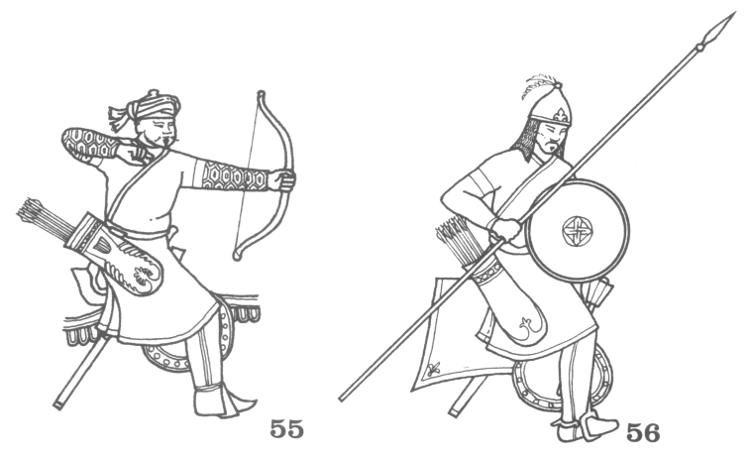
Join Amazon Prime - Watch Thousands of Movies & TV Shows Anytime - Start Free Trial Now
MAMLUKS
An extract from Armies and Enemies of the Crusades 1096-1291by Ian Heath

[based on the Baptistère de Saint Louis]


55 & 56. MAMLUKS
These figures are based on the 'Baptistère de Saint Louis' of c. 1300. Both wear 'Tartar coats' (Qaba al-Tartariyyah) which, as is obvious from the name, were of Mongol origin and followed the Mongol practice of having the Muqallab flap cross the chest from left to right as opposed to the Turkish fashion of right to left. (The left over right Mongol-style Muqallab also features in Rumi and Persian sources in the 13th century.) Such coats were often worn under a longer topcoat (see 57).
In 1283 some 1,500 Mamluk guardsmen are described as wearing red satin or silk coats, undoubtedly uniforms such as are sometimes mentioned in other contemporary sources (Fatimid Sudanese guardsmen appear to have been uniformed, and certainly as early as 1177 Saladin's personal mamluk regiment is recorded by William of Tyre wearing yellow uniforms). Red was the most common uniform colour under the Mamluks, though Ayyubid yellow was still sometimes worn. Red was also the usual colour for the Kalautah cap, usually worn with a kerchief wound round it as by figure 55. Yellow Kalautahs were worn under the Ayyubids and also by the early Mamluks up to the reign of Khalil (1290-1293). They were sometimes embroidered. The Kalautah itself appears to have been padded with cotton, probably to increase its defensive value.
Both wear sashes of coloured silk round the waist, sometimes yellow but probably more often red. Amirs, and even a few ordinary mamluk troopers, instead wore decorated Mintaqa belts, these comprising gold and silver links mounted with precious stones according to rank. Usually a black leather belt-pouch was suspended at the right.
Footwear consists of knee-length Khuff boots with coverings called Saq al-Muza worn over them. A slipper-like shoe could also be worn over the boot. The boots themselves had a clear seam down the side (see 47 and 57) and were usually of yellow or black leather in winter, white leather in summer. Red boots are also recorded.
The dress of amirs is recorded as being much richer than that of ordinary mamluks. The ceremonial dress of Amirs of 100, for instance, consisted at one time of an outer coat of red satin embroidered in gold and trimmed with miniver, and a fringed inner coat (probably a Qaba al-Tartariyyah) of yellow satin. The Kalautah was of gold brocade, with a muslin kerchief striped in white and other colours wrapped round it. Finally a beaver cloak might be worn.
Though 56 wears a helmet both appear to be otherwise unarmoured, but it should he noted that Moslems often wore body-armour beneath their outer garments in the same way that they wore helmets beneath turbans and caps (William of Tyre, for instance, records Saladin's bodyguard wearing armour under their yellow silk uniforms at Montgisard). In addition Usamah, Ibn Hudayl and other authors record how armour was often carried on pack mules and only donned immediately prior to battle.